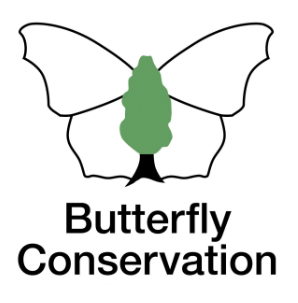Brown Argus
Brown Hairstreak
Chalkhill Blue
Clouded Yellow
Comma
Common Blue
Dark Green Fritillary
Dingy Skipper
Essex Skipper
Gatekeeper
Green Hairstreak
Green-veined White
Grizzled Skipper
Holly Blue
Large Skipper
Large White
Marbled White
Meadow Brown
Orange-tip
Painted Lady
Peacock
Purple Emperor
Purple Hairstreak
Red Admiral
Ringlet
Silver-washed Fritillary
Small Blue
Small Copper
Small Heath
Small Skipper
Small Tortoiseshell
Small White
Speckled Wood
Wall
White Admiral
White-letter Hairstreak
Extinct/rare immigrants
Peacock
Aglais io
General Distribution and Status
The Peacock is a common and widespread resident in the British Isles except the far north-west of Scotland. Its abundance has been relatively stable since the 1970s although there was a decline in the early part of this century. Its distribution has been expanding and it appeared to have reached Scotland in the 1930s (Heath et al.). In some years, there is some evidence of migration from Europe which may partly account for the fluctuating numbers. In Hertfordshire and Middlesex, numbers fell since the mid 1990s although there has been a slight recovery since 2003.
| United Kingdom | Herts & Middx | |||
| Distribution | 1976-2019 | +36% | 1980-2015 | +1% |
| Average 10-year trend | +6% | 2006-2015 | +14% | |
| 2024 since 2015-19 | +20% | |||
| Abundance | 1976-2024 | +2% | 1980-2015 | -28% |
| 2015-2024 | +11% | 2006-2015 | +56% | |
| 2023-2024 | -29% | 2024 since 2015-19 | -5% | |
UK distribution map
UKBMS Species summary
Habitat Requirements
This species can be seen anywhere except on the highest ground but more common in wooded areas.
Larval Foodplants
Common Nettle Urtica dioica.
Adult Food Sources
Buddleia Buddleja davidii (1117), Teasel Dipsacus fullonum (473), Creeping Thistle Cirsium arvense (194), Common Fleabane Pulicaria dysenterica (191), Dandelion Taraxacum sp. (162). In the spring, it is often found feeding on Willow Salix sp. and Blackthorn Prunus spinosa blossoms.
Historical Records
Herbert Matthews reports seeing this butterfly in around 1900 in Stevenage (Gibbs). Evidence suggests that the species was well distributed and sometimes common in the 20th century. Peter Bell notes in his report for 1969 that 'never, in the Tring area, have I seen so many Peacocks'.
Local Distribution and Abundance
As shown on the map, the butterfly occurs all over the Stevenage area with the highest populations in Great Ashby Park and Fairlands Valley Park. 2013 had seen a resurgence for the butterfly in terms of abundance after a lean period at the start of the century but numbers had fallen back sharply by the summer of 2018. A major recovery occurred in 2019 with many reports yielding double-digit counts including 46 east of Shephalbury Park during a Big Butterfly Count on 24 July. Many adults overwintered successfully in 2023-24 accounting for high numbers flying in the following spring but numbers were much lower later in the summer as in 2022. The best count achieved during the survey, was at Great Ashby Park on 23 July 2014 with 67 specimens reported.

Stevenage (South Fairlands Valley Park) transect 1993-2025
In spite of poor years in 2011 and 2012 as for many species including the Peacock, it has recovered well since 2005. The two best years 1996 and 2014 had contrasting fortunes in numbers of overwintering individuals and the summer brood. In 1996 a large majority were seen in late summer whereas in 2014 it was the opposite. The winter of 2013-2014 was exceptionally mild and wet which may have benefitted the hibernating adults although in the previous summer which had some hot and dry spells the number of Peacocks seen was no more than average. Did some individuals disperse into the area just prior to or after hibernation?
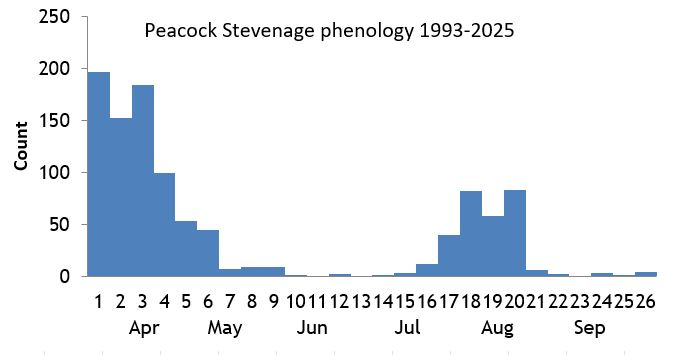
Knebworth Park transect 1996-2010 and 2017-2025
After an abundant season in 2005 this species appears to have declined. Since 2017 when the transect was resumed very low numbers recorded here with only six seen in 2019.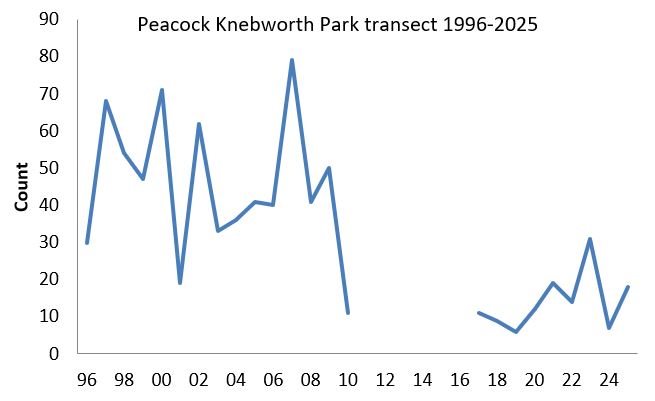
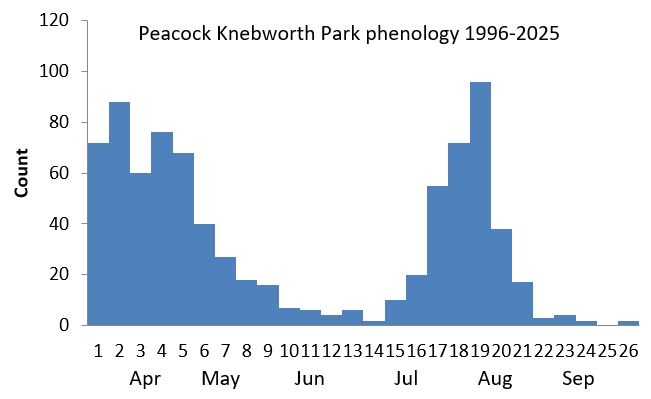
Knebworth Woods transect 2017-2025
After a disappointing season in 2018 perhaps due to the cold weather in March when many specimens perished, numbers picked up in 2019 and continuing into 2020 before dropping off in 2021. However, 2023 was the best year with 55 sightings.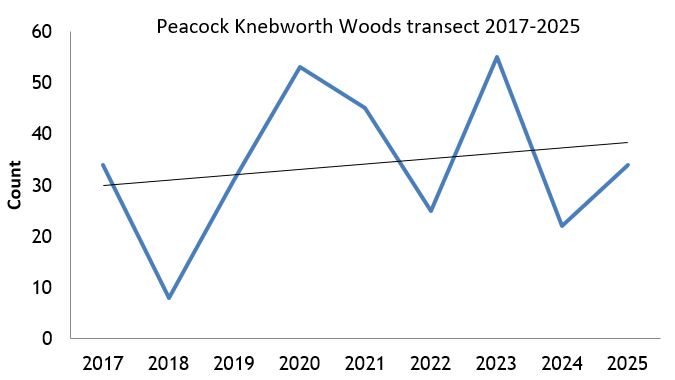
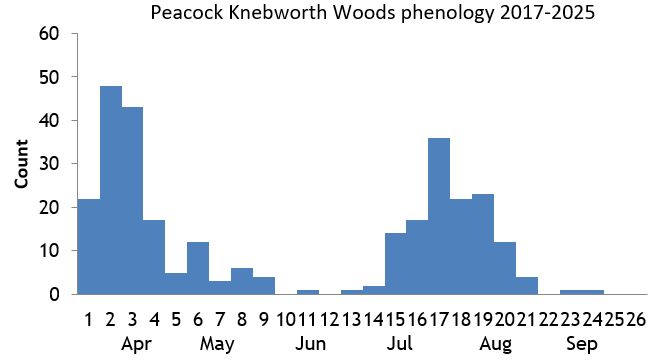
Pryor's Wood transect 2000-2022
Populations are fairly stable although there seems to be a very slight downward trend since the beginning of the decade. The best year was 2008 when 33 specimens were reported with 11 counted on 16 August.Life History
Earliest date: 21 January 2000 at River Beane Valley
Latest date: 13 November 1995 at Shilley Green
The Peacock produces
one generation a year. Overwintering adults often appear on the first warm days of the year, even early as January and continue flying until early June.
The new brood emerges in July and numbers reach a peak often in the last week of July but the butterflies usually go into hibernation by the middle of
August although some will awake on warm days until late autumn. In exceptionally warm summers, a partial second brood may also be produced. In 2009,
Dave Miller found caterpillars in August at Stanwell Moor, Staines which appears to be indicative of a second brood (Miller)
. There were also reports in the warm summer of 2018 that larvae were found at some sites in late August indicative of a second brood which emerged
in the third week of September (Wood, 2019). From May, females lay batches of eggs under leaves of tall nettle plants in sunny, sheltered places. The black larvae emerge in late May and June forming
silken webs over the leaves within which they feed. Before the end of June pupae are usually formed attached to a stem away from the foodplant.
Behaviour/Observation notes
It is a very conspicuous butterfly which usually has its wings open when basking or feeding so there should be ample opportunities to take photographs although care should be taken when approaching any such specimen. The males are territorial often in woodland rides or along hedgerows in the spring. Molehills in sheltered situations may attract a courting or mating pair; one such pair seen at Norton Green Common on 7 April 2015 is shown on the right. In the late summer or autumn much time is spent feeding to fatten up reserves for the winter hibernation.
Variations/Aberrations
There are a number of aberrations for the Peacock. Bob Clift saw what looks like ab. griseocellata where the blue tints of the eye-spots on the
forewings are changed to grey in April 2017 at Bishop's Stortford (Photo).
Find out more on the UK Butterflies website
References
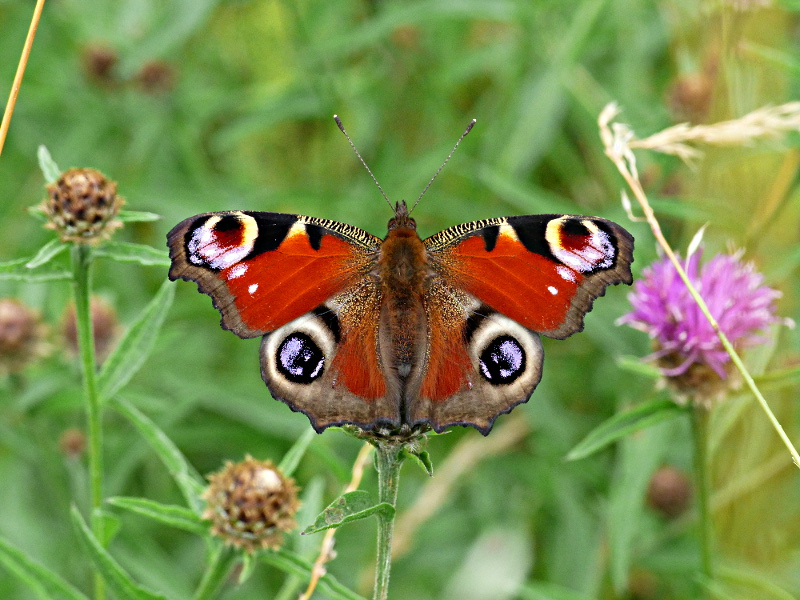
Knebworth Park 1 Aug 2019
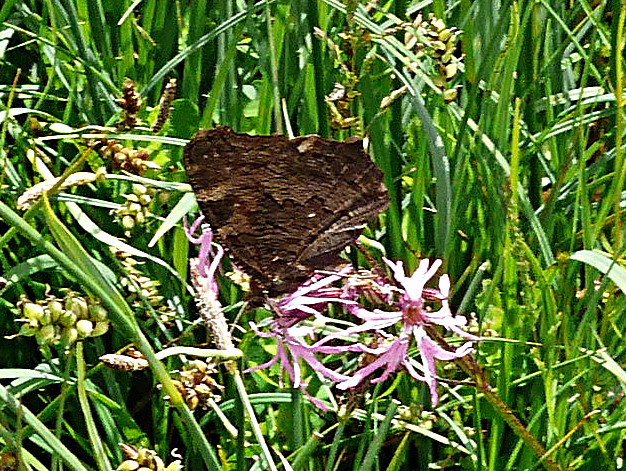
Burleigh Meadow 8 Jun 2015
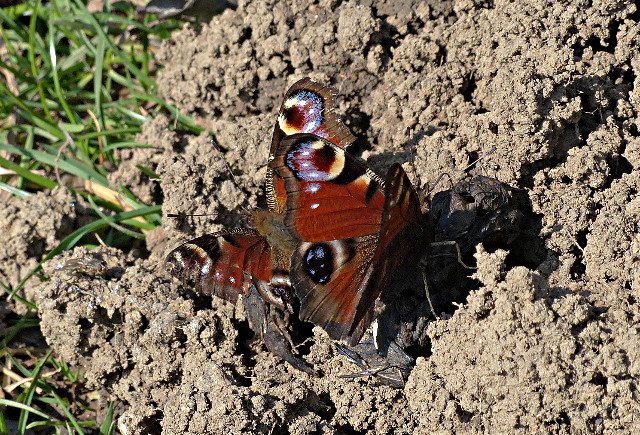
Norton Green Common 7 Apr 2015
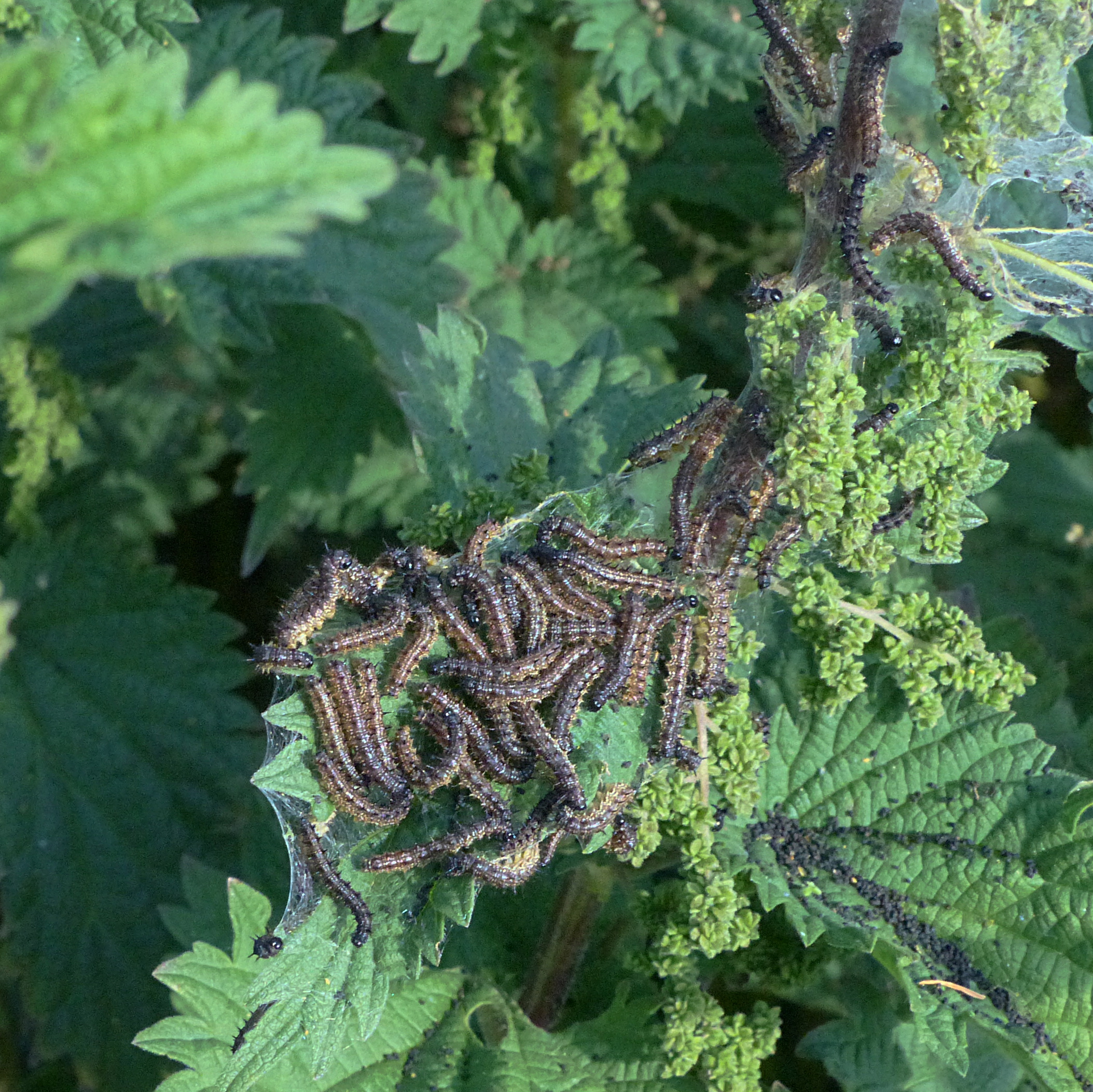
Larvae Bishop's Stortford SCP 21 Jun 2017
